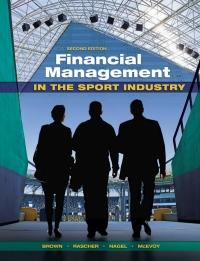Owners of sport franchises face tough decisions related to capital structure when they decide a new facility
Question:
Owners of sport franchises face tough decisions related to capital structure when they decide a new facility is needed. The St. Louis Cardinals were faced with these decisions when they decided to finance much of their new stadium privately. The Cardinals’ owners decided that a stadium was needed to replace Busch Stadium II, the team’s home from 1966 to 2005. As the plans for the new stadium (Busch Stadium III) were announced, the owners stated that the new facility was needed to generate additional revenues for the franchise. With increased revenues, the franchise would better be able to compete for top players. However, since the facility opened in 2006, the team’s debt has limited spending on payroll. In a presentation to business students at Webster University, Cardinals chairman Bill DeWitt outlined the expenses of the club. Player salaries made up 50% of the team’s expenses. Team operations (i.e., travel and coaching salaries) were another 10%, as were player development costs and facility operations expenses. Business operations accounted for 5% to 7% of expenses. The remaining portion of expenses was interest on the team’s debt (Strauss, 2009). The Cardinals are in the 21st largest media market based on households. Thanks to a loyal fan base and high attendance, the team had the sixth highest revenues in MLB as of 2015 (Forbes, 2015), generating over \($290\) million. However, player payroll was at \($133\) million in 2014. This was the 13th highest in the league. The team plans to continue to maintain a player payroll in this range as long as attendance does not decline. The owners borrowed approximately \($300\) million to build Busch Stadium III. The team pays more than \($20\) million per year in principal and interest on the two instruments that were used to finance the club’s portion of the new stadium. The club operates on tight margins and is well managed financially.
Further, with annual attendance figures for the last ten years at 3 million plus and very high local television ratings, revenues are close to maximized. Without cutting expenses elsewhere, the team has limited flexibility and cannot increase payroll without losing money.
case questions:
1. Has the Cardinals’ decision to use debt financing hurt the on-field performance of the organization? If so, how?
2. What form of debt financing did the team most likely use to raise its \($300\) million portion of the stadium construction costs?
3. What equity financing options could the club have considered to raise some of the capital to build the new stadium?
Step by Step Answer:






